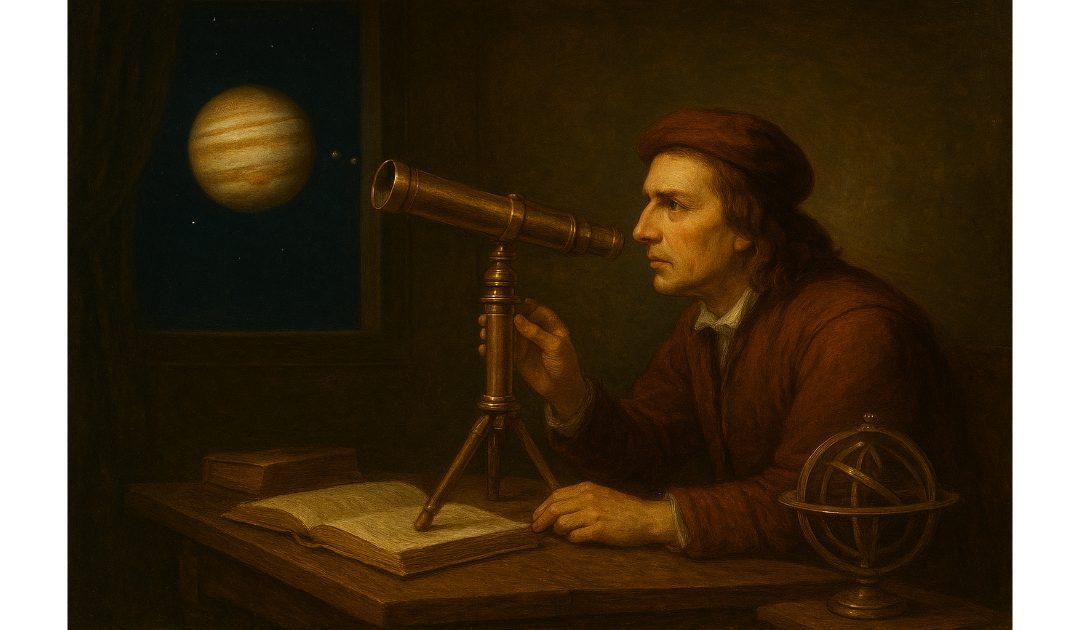Ole Rømer
On the 21st of November, 1676, Ole Rømer presented the first quantitative measurements of the speed of light.
Ole Rømer (1644–1710) was a Danish astronomer whose work in the late seventeenth century provided the first quantitative evidence that light travels at a finite speed. His achievement emerged from meticulous observations of the motions of Jupiter’s moons, particularly Io, and it marked a turning point in the study of both astronomy and physics. Rømer’s measurements and reasoning laid the foundation for understanding light as a phenomenon with measurable velocity, challenging the notion—held by some at the time—that light moved instantaneously.
Rømer studied under the guidance of the renowned French astronomer Giovanni Domenico Cassini at the Paris Observatory. The primary task of the observatory in the 1670s included refining astronomical tables, such as those predicting the orbits of Jupiter’s four largest moons, discovered by Galileo decades earlier. These moons, which include Io, Europa, Ganymede, and Callisto, had predictable eclipses as they passed into and out of Jupiter’s shadow. By precisely timing these eclipses, astronomers could improve navigation tables for determining longitude at sea. However, Rømer and Cassini began to notice that the timing of Io’s eclipses did not always align with the predictions.
As Jupiter and Earth moved through their respective orbits, Rømer observed a pattern: eclipses of Io occurred earlier than expected when Earth was moving towards Jupiter and later than expected when Earth was moving away. The discrepancy could amount to many minutes over the course of months. Cassini initially proposed that these irregularities could be due to some physical variation in Io’s orbit. Rømer, however, interpreted the phenomenon differently. He reasoned that the observed delays could be explained if light did not travel instantaneously but instead required time to cross the vast distance between Jupiter and Earth.
In 1676, Rømer presented his analysis to the French Academy of Sciences. He noted that as the Earth moved away from Jupiter, light from Io’s eclipses had to travel a slightly longer path, causing the observed events to appear delayed. Conversely, when Earth moved closer, the light’s path shortened, making the events seem earlier. By carefully comparing the timing differences over the course of the Earth’s orbit, he deduced that the cumulative delay amounted to approximately 22 minutes as Earth moved from the nearest point to the farthest point relative to Jupiter—effectively a full additional diameter of Earth’s orbit.
From this reasoning, Rømer estimated the speed of light. While he did not express his result in modern units, his calculation implied that light would take about 11 minutes to travel the distance from the Sun to the Earth (today known as the astronomical unit). This was somewhat lower than the modern value, which is just over 8 minutes and 19 seconds, but remarkable given the observational limitations of the era. More importantly, his work provided the first decisive evidence that light is not instantaneous, confirming the finite speed that had been speculated upon by thinkers like Galileo.
Rømer’s conclusion was not universally accepted immediately. Some critics suggested that the timing discrepancies could still be explained by orbital perturbations or observational errors. However, over subsequent decades, his interpretation gained credence as other measurements and methods reinforced the concept of finite light speed. In 1728, James Bradley’s discovery of the aberration of starlight offered independent proof that light travelled at a measurable velocity, further cementing the validity of Rømer’s insight.
The significance of Rømer’s measurement extends beyond the mere quantification of a physical constant. It demonstrated the power of astronomical observation as a tool for probing fundamental properties of nature. By looking outward to the motions of distant moons, Rømer was able to infer something essential about the propagation of light itself. His work also influenced Isaac Newton, who integrated the idea of finite light speed into his corpuscular theory, and it paved the way for later experimental determinations in the eighteenth and nineteenth centuries.
Rømer continued to work in Denmark after leaving Paris, contributing to the construction of instruments and the reform of the Danish calendar. Yet his legacy rests most securely on that landmark conclusion from 1676. In a period when the cosmos was still being charted with rudimentary telescopes, Rømer’s careful attention to the subtle timing of celestial phenomena revealed that even the speed of light—a concept once thought beyond human reach—could be brought within the grasp of measurement. His achievement stands as a testament to the fusion of observation, reasoning, and scientific daring that characterised the early modern revolution in astronomy.

